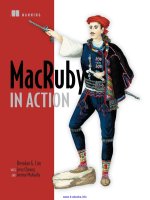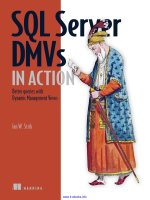Mondrian in action
Bạn đang xem bản rút gọn của tài liệu. Xem và tải ngay bản đầy đủ của tài liệu tại đây (12.82 MB, 290 trang )
Open source business analytics
William D. Back
Nicholas Goodman
Julian Hyde
www.it-ebooks.info
MANNING
Mondrian in Action
www.it-ebooks.info
www.it-ebooks.info
Mondrian in Action
OPEN SOURCE BUSINESS ANALYTICS
WILLIAM D. BACK
NICHOLAS GOODMAN
JULIAN HYDE
MANNING
Shelter Island
www.it-ebooks.info
For online information and ordering of this and other Manning books, please visit
www.manning.com. The publisher offers discounts on this book when ordered in quantity.
For more information, please contact
Special Sales Department
Manning Publications Co.
20 Baldwin Road
PO Box 261
Shelter Island, NY 11964
Email:
©2014 by Manning Publications Co. All rights reserved.
No part of this publication may be reproduced, stored in a retrieval system, or transmitted, in
any form or by means electronic, mechanical, photocopying, or otherwise, without prior written
permission of the publisher.
Many of the designations used by manufacturers and sellers to distinguish their products are
claimed as trademarks. Where those designations appear in the book, and Manning
Publications was aware of a trademark claim, the designations have been printed in initial caps
or all caps.
Recognizing the importance of preserving what has been written, it is Manning’s policy to have
the books we publish printed on acid-free paper, and we exert our best efforts to that end.
Recognizing also our responsibility to conserve the resources of our planet, Manning books are
printed on paper that is at least 15 percent recycled and processed without the use of elemental
chlorine.
Manning Publications Co.
20 Baldwin Road
Shelter Island, NY 11964
Development editor:
Copyeditor:
Proofreader:
Typesetter:
Cover designer:
ISBN 9781617290985
Printed in the United States of America
1 2 3 4 5 6 7 8 9 10 – MAL – 18 17 16 15 14 13
www.it-ebooks.info
Susanna Kline
Andy Carroll
Janet Vail
Gordan Salinovic
Marija Tudor
brief contents
1
■
Beyond reporting: business analytics
1
2
■
Mondrian: a first look 17
3
■
Creating the data mart 36
4
■
Multidimensional modeling: making analytics data accessible 57
5
■
How schemas grow
6
■
Securing data
7
■
Maximizing Mondrian performance
8
■
Dynamic security
9
■
Working with Mondrian and Pentaho
10
■
Developing with Mondrian
11
■
Advanced analytics
86
115
133
162
227
v
www.it-ebooks.info
198
176
www.it-ebooks.info
contents
preface xiii
about this book xiv
acknowledgments xviii
1
Beyond reporting: business analytics 1
1.1
The need for business analytics
2
1.2
Replacing static reports with online analytical processing
(OLAP) 4
1.3
OLAP to the rescue 8
Mondrian lets users drive analysis 8 Mondrian is a low-cost,
low-risk solution 11 Mondrian is fast 13 Mondrian is
secure 14 Mondrian is based on open standards 14
■
■
■
■
1.4
2
Summary
15
Mondrian: a first look 17
2.1
Mondrian’s role in analytics
2.2
Running and using Mondrian
18
19
Getting and running the software 20 Navigation and viewing
reports 22 Interactive analytics 24 MDX analysis with
Saiku 25
■
■
■
vii
www.it-ebooks.info
viii
CONTENTS
2.3
Multidimensional modeling
A simple report
2.4
27
■
27
Modeling business questions
Getting and organizing the data
28
30
The data warehouse: physically storing the data 31 Examining
the Adventure Works data 32 Populating the data 33
■
■
2.5
3
Summary
34
Creating the data mart 36
3.1
Structuring data for analytics
37
Characteristics of analytic systems 37 Data architecture for
analytics 38 Star schemas 40 Comparing star schemas with
3NF 42 Star schema benefits 43
■
■
■
■
3.2
Additional star schema modeling techniques
44
Slowly Changing Dimensions (SCDs) 44 Time dimensions
Snowflake design 52 Degenerate and combination/junk
dimensions 54
■
50
■
3.3
4
Summary
56
Multidimensional modeling: making analytics data
accessible 57
4.1
A simple schema
58
Schema element 60 Cube element 61 Attribute element 62
Dimension element 65 Measure element 65 PhysicalSchema
element 66
■
■
■
4.2
■
Anatomy of a schema 70
XML schema files 70 Structure of a schema 71
versioning and upgrading 71
■
4.3
Dimensions, hierarchies, and levels
Schema
■
73
Hierarchies and levels 73 Time dimension 77
hierarchies 81 The measures dimension 83
■
■
Attribute
■
4.4
5
Summary
84
How schemas grow 86
5.1
Schema evolution
87
Multiple cubes in a schema 88 Shared dimensions 89
Conformed dimensions 90 Using a dimension twice in the same
cube 91 Measures across multiple fact tables 91 Smart
evolution: multiple cubes versus single cubes 95 Other schema
evolution patterns 96
■
■
■
■
■
www.it-ebooks.info
ix
CONTENTS
5.2
Alternative ways to store dimensions
Star dimensions 98
dimensions 101
5.3
■
Advanced hierarchy structures
Parent-child hierarchies 102
5.4
Calculations
6
■
■
Degenerate
102
Ragged hierarchies 104
106
Bucketing attributes
5.5
97
Snowflake dimensions 98
106
■
Calculated members 107
Summary 114
Securing data 115
6.1
Use of roles
116
What’s a role? 116 Declaring roles in the Mondrian schema 118
Enforcement of roles 118
■
6.2
Security grants
122
Schema grants 123 Cube grants 124 Dimension and hierarchy
grants 126 Member grants 128 Measure grants 131
■
■
■
6.3
7
■
Summary 132
Maximizing Mondrian performance 133
7.1
Figuring out where the problems are
134
Performance improvement process 134 Preparing for
performance analysis and establishing current performance 135
■
7.2
Tuning the database 138
7.3
Aggregate tables
139
Creating aggregate tables 141 Declaring an aggregate
table 142 Which aggregates should you create? 143
■
■
7.4
Caching
143
Types of caches
144
■
External segment cache
7.5
Priming the cache
7.6
Flushing the cache 156
146
152
Flushing the schema cache 156 Flushing specific cubes 159
Flushing specific regions of the cache 160
■
7.7
8
Summary 161
Dynamic security 162
8.1
Preparing for dynamic security
Creating an action sequence
action sequence 164
163
www.it-ebooks.info
163
■
Configuring and running the
x
CONTENTS
8.2
Restricting data using a dynamic schema processor
165
Modifying the schema to support a DSP 166 Example dynamic
schema processor 166 Configuring the DSP 167
■
■
8.3
Restricting data using dynamic role modification
Preparing the schema 170 Custom MDX connection
Custom delegate role and custom hierarchy access 172
Configuring the custom MDX connection 173
■
9
8.4
Deciding which security approach to use
8.5
Summary 175
169
171
174
Working with Mondrian and Pentaho 176
9.1
Pentaho Analyzer 177
Overview of Pentaho Analyzer 177 Using Analyzer for
analysis 178 Charting with Analyzer 181 Special schema
annotations for using Analyzer 183
■
■
■
9.2
Saiku
185
9.3
Community Dashboard Framework
Creating a CDF dashboard
Access 187
9.4
186
Pentaho Report Designer
185
Using Community Data
■
189
Creating an OLAP data source 189 Using parameters 193
PRD and the dynamic schema processor 194
■
10
9.5
Pentaho Data Integration 195
9.6
Summary 197
Developing with Mondrian
10.1
198
Calling Mondrian from a thin client 200
XML for Analysis (XMLA) 200 Configuring Mondrian as an
XMLA web service 201 Calling XMLA services with Ajax 202
XMLA for JavaScript (xmla4js) 218
■
■
10.2
Calling Mondrian from a Java application 222
Creating connections via olap4j
10.3
11
222
■
Querying data
223
Summary 226
Advanced analytics 227
11.1
Advanced analytics in Mondrian with MDX
Running MDX queries 229 Ratios and growth
specific MDX 233 Advanced MDX 234
■
■
www.it-ebooks.info
227
229
■
Time-
xi
CONTENTS
11.2
What-if analysis
11.3
Statistics and machine learning
R 242
11.4
■
Big Data
Weka
238
241
242
243
Analytic databases 244 Hadoop and Hive
systems and Hadoop 245
■
11.5
appendix A
appendix B
appendix C
Summary 247
Installing and running Mondrian
Online resources 252
Schema shortcuts 255
index
257
www.it-ebooks.info
249
245
■
NoSQL
www.it-ebooks.info
preface
I joined Pentaho in 2011 with only a vague notion of business analytics or Mondrian
and was told by my boss at the time that I should focus on becoming the Mondrian
“expert” on the team. As I do when learning any new technology, my first action was to
create a personal project to implement. In addition to my personal efforts, I was also
assigned to support several clients dealing with Mondrian-related challenges.
As I started looking at the documentation and learning Mondrian, I quickly discovered that useful information was in multiple places, including the Mondrian site, forums,
product websites, best practices, and even just in the heads of people who had been working with Mondrian for a while. To help myself, I began gathering notes together in one
location and got the idea that a book on Mondrian would be very helpful.
After some encouragement from various friends and coworkers, I contacted Julian
Hyde, who also recommended Nick Goodman for the project. Together we agreed
that it was a good idea, so we started checking around for reputable publishers. Since
I already had a shelf, both physical and virtual, full of Manning books, it wasn’t really a
difficult choice.
This book is the work of the authors over the course of more than a year, but contains information created by multiple developers and communities over a decade. If
you’re already using Mondrian, I hope you’ll find this a useful reference and learn a
thing or two, particularly about the upcoming Mondrian 4.0. If you’re new to Mondrian, then I hope you’ll find this a useful learning tool that covers both the basics
and advanced topics. No matter where you fall on the Mondrian knowledge scale, I
hope you’ll find this book and the tools contained in it a useful aid in helping businesses make better decisions.
WILLIAM BACK
xiii
www.it-ebooks.info
about this book
This book is about Mondrian 4.0 and related technologies. It’s organized into chapters based on functionality. Chapters are designed to be standalone in most cases, but
it’s easier, especially for beginners, to start at the beginning and work through the
chapters of interest in order. Depending on your role in the organization, different
chapters will be more relevant than others.
Intended audience
This book is targeted at four general types of users:
The business analyst is the person who will use Mondrian to perform analysis. This
reader mainly wants to use Mondrian and the related tools, not necessarily understand all of the inner workings, such as configuration and database format.
The data warehouse architect is the person who’s responsible for setting up the data
for Mondrian for business analysts to use. This person makes it possible for analysis to
be fast and easy.
The business intelligence enterprise architect is responsible for making Mondrian work
within the enterprise. This includes installation, configuration, scaling, and security.
Finally, application developers will want to learn how to integrate Mondrian in their
own applications. Integration approaches include embedding the Mondrian engine
into your application as well as using Mondrian’s web services to get data.
Roadmap
Here’s what you’ll learn in each chapter:
xiv
www.it-ebooks.info
ABOUT THIS BOOK
■
■
■
■
■
■
■
■
■
■
■
xv
Chapter 1 introduces you to business analytics and why you’d want to use a tool
like Mondrian. After reading this chapter you should have an understanding of
the problem that Mondrian is trying to solve. You’ll also understand how Mondrian fits into the larger business analytics architecture.
Chapter 2 gives you a high-level overview of Mondrian and how it works to support the enterprise. This chapter provides general context for most of the rest
of the book. By reading this chapter you should understand what Mondrian can
do for your organization.
Chapter 3 introduces the concept of star schemas and data marts. This chapter
explains why and how to organize the data for maximum effectiveness with
Mondrian. After finishing this chapter you’ll understand why certain data organization is better than others and how to create data marts for your solution.
Chapter 4 presents the fundamentals of the Mondrian schema. This schema
logically describes the data in the database. You’ll be able to create your own
schemas for analysis after reading this chapter.
Chapter 5 expands on chapter 4 and looks at advanced schema features. It
includes features such as parent-child hierarchies and hanger dimensions that
allow you to model more complex data. After reading this chapter and chapter 4 you’ll know the vast majority of all Mondrian schema features.
Chapter 6 introduces the concept of roles and security. You’ll learn how to
restrict access to data for users based on their role—for example, limiting cost
information to cost accountants and financial managers.
Chapter 7 talks about how to maximize Mondrian performance. In particular
you’ll learn how to create and configure aggregate tables and use advanced inmemory caching features to make analysis with Mondrian even faster.
Chapter 8 revisits the question of security to include dynamically setting access
to data as well as support for multi-tenancy. This chapter is of particular interest
to anyone managing a large-scale Mondrian installation with many users,
including external clients.
Chapter 9 talks about how Mondrian is used within Pentaho, the leading open
source business analytics framework. You will learn how to use Mondrian as a
source for analytics, reporting, and dashboards. This chapter also describes
using Mondrian with the Community Dashboard Framework, a popular open
source plug-in for Pentaho.
Chapter 10 is for the developers who want to either embed Mondrian into their
application or use it as a source of analytics data. Detailed examples are provided to help you create your own solutions.
Chapter 11 wraps up the book with an overview of some advanced analytics topics. It shows how to perform advanced analytics within Mondrian and use popular data mining tools. We also place Mondrian in the Big Data landscape.
www.it-ebooks.info
xvi
ABOUT THIS BOOK
Recommended reading
Table 1 shows the chapter likely to be of most interest to each type of reader. That’s not
to say that the other chapters won’t also be of interest, but that these are most relevant.
Table 1
Relevant chapters by reader
Business
Data
Enterprise Application
Analyst Architect Architect Developer
Chapter
Chapter 1, “Beyond reporting: business
analytics”
✓
✓
✓
✓
Chapter 2, “Mondrian: a first look”
✓
✓
✓
✓
Chapter 3, “Creating the data mart”
✓
Chapter 4, “Multidimensional modeling: making
analytics data accessible”
✓
✓
Chapter 5, “How schemas grow”
✓
✓
Chapter 6, “Securing data”
✓
✓
Chapter 7, “Maximizing Mondrian performance”
✓
✓
Chapter 8, “Dynamic security”
Chapter 9, “Working with Mondrian and Pentaho”
✓
✓
✓
✓
✓
Chapter 10, “Developing with Mondrian”
✓
Chapter 11, “Advanced analytics”
✓
✓
✓
✓
Code conventions and downloads
The code in this book is generally in individual listings. When code is inline it’ll be
specified by code markings to make it easily identifiable. Code is set in a fixed-width
font like this.
Note that the listings only show what’s necessary to explain something. You should
download the software to get the full examples. See appendix A for more information
on how to download the software; go to the publisher’s website at www.manning.com/
MondrianinAction to download the examples.
Software requirements
The code in this book, when specific to Mondrian, is for Mondrian 4.0. Most will work
with Mondrian 3.5 or later. Mondrian 4.0 will be released as part of Pentaho 5.1 in
early 2014. You can currently use Mondrian 4.0 with Saiku, which was used to validate
the examples in this book. If you encounter problems with the code examples in this
book, please let the authors know in the Manning Author Online forum.
In addition to the software described in appendix A, you’ll need a system capable
of running Java and a web browser. The code has been tested with Java 1.6, but should
also run on Java 1.7 or later. You’ll also need a database that’s supported by Mondrian,
such as MySQL or PostgreSQL.
www.it-ebooks.info
ABOUT THIS BOOK
xvii
An IDE that supports HTML, Javascript, XML, and Java, such as IntelliJ Idea or
Eclipse, is ideal but not required. You can enter all of the examples in a text editor
and compile from the command line. But an IDE will make it a lot easier.
Author Online
The purchase of Mondrian in Action includes free access to a private web forum run by
Manning Publications, where you can make comments about the book, ask technical
questions, and receive help from the authors and from other users. To access the
forum and subscribe to it, point your web browser at www.manning.com/MondrianinAction. This page provides information on how to get on the forum once you are
registered, what kind of help is available, and the rules of conduct on the forum.
Manning’s commitment to our readers is to provide a venue where a meaningful
dialogue between individual readers and between readers and the authors can take
place. It’s not a commitment to any specific amount of participation on the part of the
authors, whose contribution to the forum remains voluntary (and unpaid). We suggest you try asking the authors some challenging questions, lest their interest stray!
The Author Online forum and archives of previous discussions will be accessible
from the publisher’s website as long as the book is in print.
About the cover illustration
The figure on the cover of Mondrian in Action is captioned a “Man from Konavle.” The
illustration is taken from the reproduction published in 2006 of a 19th-century collection of costumes and ethnographic descriptions entitled Dalmatia by Professor Frane
Carrara (1812 – 1854), an archaeologist and historian, and the first director of the
Museum of Antiquity in Split, Croatia. The illustrations were obtained from a helpful
librarian at the Ethnographic Museum (formerly the Museum of Antiquity), itself situated in the Roman core of the medieval center of Split: the ruins of Emperor Diocletian’s retirement palace from around AD 304. The book includes finely colored
illustrations of figures from different regions of Croatia, accompanied by descriptions
of the costumes and of everyday life.
Konavle is a small town located southeast of Dubrovnik, Croatia. The man on the
cover is wearing dark blue woolen trousers and an embroidered red vest over a white
linen shirt. Over his shoulders is draped a brown woolen shawl, and a gold sash and
red leggings complete his outfit. In his hand he holds a long pipe, and pistols and a
musket are visible, stuck in his sash and hanging over his shoulder.
At a time when it is hard to tell one computer book from another, Manning celebrates the inventiveness and initiative of the computer business with book covers
based on the rich diversity of regional life of two centuries ago, brought back to life by
illustrations from collections such as this one.
www.it-ebooks.info
acknowledgments
We’d like to thank the staff at Manning who helped make this book a reality. First,
Bert Bates patiently taught us the fundamentals of telling a story, rather than simply
writing dry, technical prose. Nick Chase helped with the technical aspects, fixing
errors and answering basic questions that helped move the project along. Immense
thanks to Susanna Kline, who not only made the book of much higher quality and
guided us through the process, but also kept us going when we didn’t want to. Without Susanna’s assistance, we’d still be back somewhere in chapter 3, talking about how
we should be writing more. A good editor makes a finished product possible. Finally,
thanks to the marketing and production teams at Manning for their support, guidance, and encouragement throughout the publication process.
Though it’s impossible to list everyone who provided input, we’d specifically like to
thank Anthony DeShazor, Will Gorman, and Luc Boudreau for support and guidance
as well as technical and operational insights. The Saiku team, and their lead Paul
Stoellberger, were very helpful in testing Mondrian 4.0 and ensuring accurate content
for this book. Thank you to Kevin Hanrahan who, although new to Mondrian, worked
through examples and provided feedback on errors and omissions. We’d also like to
thank the management of Pentaho for being supportive of this effort and allowing us
to reuse some internal Pentaho content. Thank you also to our colleagues and friends
at Pentaho and in the Pentaho and Mondrian community for creating such a great set
of technology and tools.
We’d like to thank the reviewers who took time to read the drafts of our manuscript
and provide feedback so that we could make the book easier to read and understand.
xviii
www.it-ebooks.info
ACKNOWLEDGMENTS
xix
Many a poorly written section or so-so graphic was improved by input from our reviewers: Aiden Humphreys, Alexander Helf, Barry Polley, Dan McCreary, Filip Rembiałkowski, Garry Turkington, Greg Soulsby, Lorenzo De Leon, Marc-Steffen Kaesz,
Mark Newman, Marko Viitanen, Matt Taylor, Nadia Noori, Najib Coutya, Owen Kaser,
Ron Steiger, Saeed Alhajyousef, Salvatore Piccione, and Simon (Zihong) Wang. Thanks
also to David Fombella Pombal and Gavin Whyte for their careful technical review of the
final chapters shortly before they went into production.
WILLIAM BACK
You always read about how much work writing a book is and how it takes a team. The
reality of that fact didn’t hit me until I attempted to write a book of my own. My first
clue that I was taking on a large project should’ve been when former authors told me
what a great idea it was, but declined to participate. It’s a lot of work, and it does take
a lot of help.
I have to first thank my wife, Tara, and my children, Lauren and Nathan. They’ve
been very patient in allowing me to spend hours and weekends locked away in my
office or talking with my coauthors. Family support is a must because of the time it
takes to write a book.
I also want to thank my coauthors, Julian Hyde and Nick Goodman. They had
much more experience and background with past versions of Mondrian and provided
a lot of insight into how Mondrian can and should be used. The Mondrian 4.0 features in this book would’ve been impossible to include without Julian’s knowledge of
the latest version.
NICHOLAS GOODMAN
It’s easy to wonder why anyone would write a book at all; it’s immensely time-consuming,
requires more effort than anyone thinks or knows, and can be downright frustrating.
This book, however, is something I’m proud to have been a part of, and it certainly would
not have happened by me alone.
Julian Hyde is a long-time colleague and friend, and I’m grateful we were able to
work on this project together. His efforts shepherding Mondrian over the course of a
decade are commendable, and his talents numerous. I’m honored that he and Bill
asked me to play a small part as coauthor on this much-overdue project.
Bill Back is the heart and soul of this book! His desire to learn, explore, perfect,
communicate, and teach are all present, and in no uncertain terms this book wouldn’t
have made it past a proposal had it not been for his desire to do this project well. If
there were a way to make Bill’s name 10x the size of mine on the cover, he’d deserve
all that extra credit and more!
To my wife, Kathleen, who listened to me complain and wondered why I ever took
on this project, but still encouraged me to just “go work on the book for a couple
hours” here and there—you are the only reason the team at Manning received any
content from me. To my daughter, Emmeline, who was born during the final days of
www.it-ebooks.info
xx
ACKNOWLEDGMENTS
this book—you’ll be glad to know that daddy was doing something productive during
those middle-of-the-night sessions!
JULIAN HYDE
I once said I’d never bet my job on a technology about which no one had seen fit to
write a book. Thankfully the Mondrian community isn’t as conservative as me! Over
the past decade, many people have used Mondrian successfully based on information
gleaned from forums, the developer mailing list, and the less-than-perfect online documentation. You’ve helped each other out, and inspired the developers to make Mondrian faster and better. This book is the culmination of a long journey, and is my way
of saying thank you for your patience and support.
Mondrian is an open source project, but its chief inspiration was a commercial
product: Microsoft Analysis Services. Its architects—Amir and Ariel Netz and Mosha
Pasumansky—radically simplified OLAP. Their product had a query language, MDX,
and standard interfaces OLE DB for OLAP and XML/A, where all previous products
had required building queries using a proprietary API. Their hybrid architecture combined the convenience of ROLAP with the performance and expressive power of
MOLAP. Mondrian wouldn’t have been possible without their work creating standard
languages, APIs, and architectures.
Every open source project is part of a wider movement. Thank you to all open
source software developers out there. We use your software every day for development, debugging, builds, and testing, and you probably don’t even know it.
Mondrian has a number of crucial “sister projects”; we literally grew up together.
The first, JPivot, started when Andreas Voss flew from Germany to meet me in San
Francisco. His company wanted to develop a web-based pivot table; they would build it
on top of my fledgling Mondrian project and release it open source if I made sure that
Mondrian had the features they needed. We shook hands, and that was that. Other
projects followed: LucidDB (John Sichi, Rushan Chen, Zelaine Fong); LucidEra
Clearview, which became Pentaho Analyzer (Benny Chow); olap4j (Luc Boudreau and
Barry Klawans); OpenI (Sandeep Giri); Saiku (Paul Stoellberger and Tom Barber);
and CTools (Pedro Alves).
Many people have contributed code to Mondrian, and I’m grateful to them all. We
grow best and fastest when developers and architects bring challenging problems, and
work with us to solve them. So, thanks to Joe Barnett, Marc Berkowitz, Roland Bouman, Matt Campbell, Matt Casters, Gang Chen, Dan Dosch, Daniel Einspanjer, Richard Emberson, Sarah Gerweck, Will Gorman, Brandon Jackson, Sean McCullough,
Eric McDermid, Gretchen Moran, Thomas Morgner, Henry Olson, Kurt Walker, and
Sherman Wood.
Open source BI wasn’t always with us. Mark Madsen, Seth Grimes, Nicholas Goodman, James Dixon, and Jos van Dongen explained to the world how open source BI,
and in particular Mondrian, could change business. And I’d like to thank Richard
www.it-ebooks.info
ACKNOWLEDGMENTS
xxi
Daley and the whole Pentaho team for their faith and investment in Mondrian and
open source BI technology.
Writing a book is hard work. Thank you to my coauthors, Bill and Nick, and to our
editor Susanna Kline, for their insight, stamina, and patience. And thank you to my
brother Justin and my friend Gordon Cameron, who were always happy to discuss
dimensional modeling over a beer or two at Barclay’s pub. You helped keep me sane.
Building a piece of technology, and now writing a book, requires commitment and
sacrifice, not just from the author, but from his family, who are rarely asked or
thanked. My son, now 4, has learned the pattern from his mother: yesterday he said,
“Are you going to work at your computer again tonight, Daddy?” Thank you to my
wife, Pamela, for everything; and to my sons, Sebastian and Theodore, who will love
reading their names in print.
www.it-ebooks.info
www.it-ebooks.info
Beyond reporting:
business analytics
This chapter covers
■
The complexity of database-based reports
■
Advantages of OLAP reporting tools
■
Reasons for using Mondrian
Business analytics is a process for gaining insight into business performance based
on the analysis of historical data. Traditionally the tools used for business analytics
have been expensive and difficult to maintain. Mondrian, in contrast, is an open
source business analytics tool that enables organizations of any size to give business
users access to the data for interactive analysis and to create analysis reports without the help of IT or database administrators. Once the data has been set up, users
can interact with it directly. This book will present you with the concepts and technical know-how to use Mondrian, including how to organize the data for easy
access, how to securely make your data available, and how to integrate this data
into other applications.
This first chapter will introduce you to some of the common problems encountered with a report-based approach to analysis. We’ll show you the complexity
1
www.it-ebooks.info
2
CHAPTER 1
Beyond reporting: business analytics
involved in creating database reports and why they’re not a good fit for analysis. Then
we’ll demonstrate how Mondrian can be used to overcome those challenges and
explain some of the features that make Mondrian an ideal choice. Finally, we’ll provide an overview of the remainder of the book, where we’ll expand on all of the
aspects of Mondrian and teach you how to use Mondrian effectively for analysis.
1.1
The need for business analytics
In his book Moneyball, Michael Lewis tells the story of how the Oakland A’s managed to
put together a highly talented and competitive team on one of the lowest budgets in
professional baseball. Prior to this time, scouting was done by scouts watching players
and going on gut feel as to who would develop into a professional. As the cost of recruiting players skyrocketed, so did the cost of making an error in signing the wrong guy.
Billy Beane, Oakland’s general manager, decided that they needed a more analytical approach. He brought in analysts who would study the statistics of college players
and identify players who were good candidates, but who had been overlooked by
scouts for a variety of reasons. Statistics such as on-base percentage and number of
walks per bat became important considerations that weren’t considered important
before. This gave Oakland an edge in drafting players that other teams didn’t recognize as valuable and signing them for less.
Like the Oakland A’s, today’s businesses need to be able to optimize their spending
to maximize return on investment. Controlling aspects of the business such as inventory costs, waste, excess machinery or labor, and returns is no longer optional, but mandatory to survive in the hyper-competitive, intelligence-driven marketplace. And
businesses need good tools and processes to make this happen. The A’s wrote much of
their own software, but that approach is typically very expensive, slow, and risky. With
Mondrian, any organization can have access to world-class analytics tools that they can
get up and running quickly with a minimum of cost and risk.
Historically, analysis and management of business has been done using spreadsheets, operational databases, and reports. While these approaches are good for viewing predefined data formats, they’re not as good for exploring and discovering new
information because reports are often difficult and time consuming to create and
manipulate. Online analytical processing (OLAP) is a technology that makes business
data available with enough structure for business users to easily explore data and discover important data relationships without having to understand database query languages or the organization of a company’s operational databases.
The following are some of the types of discoveries companies can make with OLAP
tools and how these discoveries help their businesses:
■
■
Discovering that a particular product is in high demand in summer months, but
low demand outside of those months. The company can now adjust inventory
seasonally to avoid excessive storage costs.
Finding out that there’s a change in demand for services after running ads in
various publications. The company can now coordinate advertising and staffing
www.it-ebooks.info









